The Radioactive Iodine Ablation Therapy Market is estimated to be valued at USD 535.2 million in 2025 and is projected to reach USD 871.8 million by 2035, registering a compound annual growth rate (CAGR) of 5.0% over the forecast period.
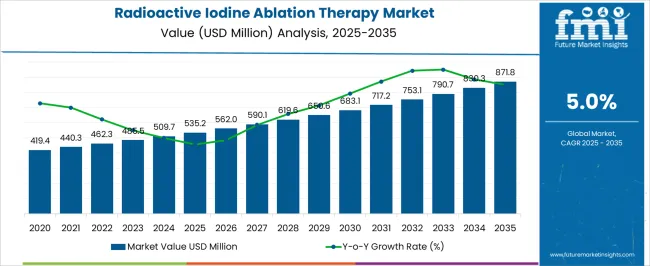
| Metric | Value |
|---|---|
| Radioactive Iodine Ablation Therapy Market Estimated Value in (2025 E) | USD 535.2 million |
| Radioactive Iodine Ablation Therapy Market Forecast Value in (2035 F) | USD 871.8 million |
| Forecast CAGR (2025 to 2035) | 5.0% |
The Radioactive Iodine Ablation Therapy market is witnessing steady growth as a result of its established role in treating thyroid cancers and the rising global incidence of such conditions. The market is being shaped by advancements in nuclear medicine, improvements in targeted therapeutic delivery, and a growing emphasis on personalized oncology care. Increasing awareness about the benefits of minimally invasive and organ-preserving treatments has further enhanced the adoption of radioactive iodine therapies.
Hospitals and research centers are integrating advanced radiation technologies to improve treatment outcomes, while governments and healthcare systems are supporting nuclear medicine infrastructure to meet growing patient demand. Rising cases of papillary thyroid cancer and supportive clinical guidelines recommending radioactive iodine therapy as a primary or adjunct treatment option are acting as strong demand drivers.
The future outlook remains positive, with ongoing research aimed at enhancing dosing protocols, minimizing side effects, and expanding therapeutic applications beyond thyroid disorders This trajectory positions the market for consistent growth in both established and emerging healthcare systems.
The radioactive iodine ablation therapy market is segmented by application, technology, end user, and geographic regions. By application, radioactive iodine ablation therapy market is divided into Papillary Thyroid Cancer, Follicular Thyroid Cancer, and Hurthle Cell Carcinoma. In terms of technology, radioactive iodine ablation therapy market is classified into Gamma Radiation and Beta Radiation. Based on end user, radioactive iodine ablation therapy market is segmented into Hospitals, Cancer Research Organizations, Radiotherapy Centers, and Research & Development Companies. Regionally, the radioactive iodine ablation therapy industry is classified into North America, Latin America, Western Europe, Eastern Europe, Balkan & Baltic Countries, Russia & Belarus, Central Asia, East Asia, South Asia & Pacific, and the Middle East & Africa.
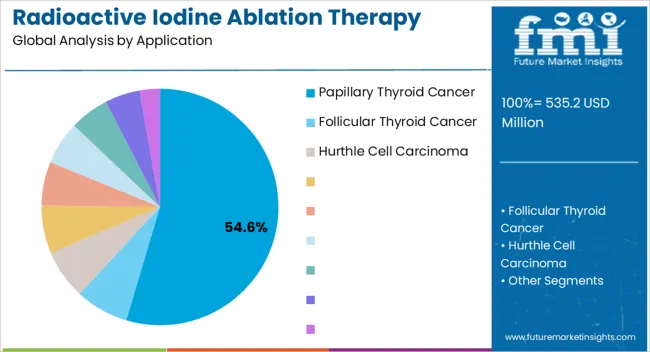
The Papillary Thyroid Cancer application segment is projected to account for 54.60% of the overall Radioactive Iodine Ablation Therapy market revenue in 2025, making it the leading application area. This dominance is being attributed to the high prevalence of papillary thyroid carcinoma, which represents the majority of thyroid cancer diagnoses globally. The effectiveness of radioactive iodine in targeting residual thyroid tissue and metastatic disease has established it as a critical component of treatment protocols for this cancer type.
Clinical guidelines widely recommend radioactive iodine ablation following thyroidectomy to improve survival outcomes and reduce recurrence risks, which has reinforced adoption. The ease of integrating this therapy into existing oncology workflows and its proven safety profile have further driven utilization.
Rising awareness campaigns promoting early detection of thyroid cancers have resulted in growing patient pools, which has sustained demand for this therapeutic approach As advancements in dosimetry and imaging continue to optimize therapy outcomes, papillary thyroid cancer is expected to remain the primary driver of revenue in this market.
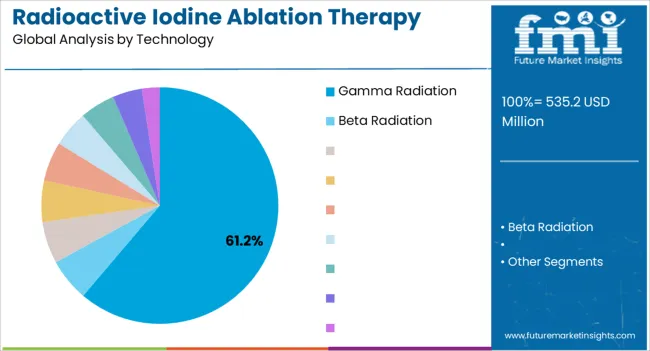
The Gamma Radiation technology segment is expected to account for 61.20% of the total Radioactive Iodine Ablation Therapy market revenue in 2025, positioning it as the leading technological approach. This leadership has been driven by the established efficacy of gamma radiation in delivering precise therapeutic doses that selectively target thyroid tissues while sparing surrounding organs. The segment’s dominance is being reinforced by its compatibility with existing nuclear medicine infrastructure and its proven safety and reliability in clinical practice.
Hospitals and specialized treatment centers have prioritized gamma-based systems due to their ability to provide consistent outcomes and manageable side effect profiles. The availability of advanced dosimetry and imaging tools that complement gamma radiation therapy has further improved accuracy and patient confidence in treatment.
Growing investments in nuclear medicine facilities and training programs have also expanded accessibility, making gamma radiation the preferred choice With rising adoption across both developed and developing healthcare systems, this technology is expected to sustain its leadership in the foreseeable future.
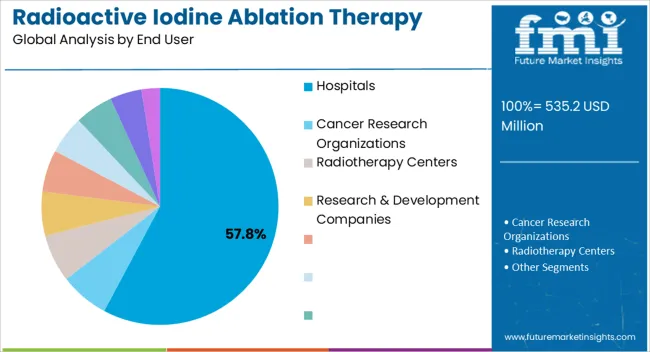
The Hospitals end-user segment is anticipated to capture 57.80% of the overall Radioactive Iodine Ablation Therapy market revenue in 2025, emerging as the leading consumer group. This growth has been supported by the concentration of advanced treatment facilities, skilled nuclear medicine specialists, and comprehensive care infrastructure within hospitals. Patients prefer hospitals due to the availability of multidisciplinary teams, which ensures holistic management of thyroid cancer from diagnosis to therapy and follow-up.
Hospitals have also benefited from significant investments in nuclear medicine units, including advanced imaging, radiation shielding, and safety infrastructure that are essential for radioactive iodine therapy. The ability to provide integrated care, including surgery, ablation therapy, and long-term monitoring, has further consolidated their position as the primary treatment centers.
Rising patient inflow, coupled with supportive insurance coverage for hospital-based nuclear medicine treatments, has reinforced adoption As healthcare providers continue to modernize facilities and expand oncology departments, hospitals are expected to remain the dominant end-user segment, driving sustained demand for radioactive iodine ablation therapies.
Radioactive iodine ablation therapy also known as radioiodine remnant ablation which improves survival rate of patients which affected by follicular or papillary thyroid cancer. According to WHO thyroid cancer is differentiated into papillary and follicular thyroid cancer. Abnormal cell or cancerous cell begin to grow in thyroid gland then Thyroid cancer occurs which excretes thyroid hormones excessively. Thyroid cancer is very uncommon type of cancer. Radioactive iodine also known as I-131 when taken into the body in any form such as Capsule or liquid form and concentrates in thyroid cells. Radioactive iodine ablation therapy can destroy the thyroid gland and any other thyroid cells.
Radioactive iodine ablation therapy is used to destroy any thyroid tissue which does not removed by surgery or to treat some types of thyroid cancer that have spread to lymph nodes and other parts of the body. Radioactive iodine ablation therapy accurately diagnose and treat thyroid cancer. Radioactive iodine ablation therapy are highly painless, effective and cosmetically alternative to surgery for selected cancers. Radioactive iodine ablation therapy destroy remaining thyroid cells after a thyroidectomy. Radioactive Iodine Ablation Therapy decreases the chance of developing a thyroid cancer.
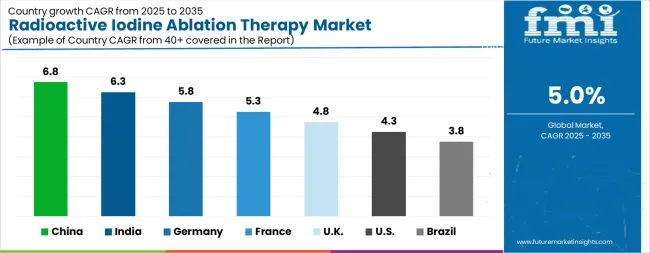
| Country | CAGR |
|---|---|
| China | 6.8% |
| India | 6.3% |
| Germany | 5.8% |
| France | 5.3% |
| UK | 4.8% |
| USA | 4.3% |
| Brazil | 3.8% |
The Radioactive Iodine Ablation Therapy Market is expected to register a CAGR of 5.0% during the forecast period, exhibiting varied country level momentum. China leads with the highest CAGR of 6.8%, followed by India at 6.3%. Developed markets such as Germany, France, and the UK continue to expand steadily, while the USA is likely to grow at consistent rates. Brazil posts the lowest CAGR at 3.8%, yet still underscores a broadly positive trajectory for the global Radioactive Iodine Ablation Therapy Market. In 2024, Germany held a dominant revenue in the Western Europe market and is expected to grow with a CAGR of 5.8%. The USA Radioactive Iodine Ablation Therapy Market is estimated to be valued at USD 190.3 million in 2025 and is anticipated to reach a valuation of USD 288.6 million by 2035. Sales are projected to rise at a CAGR of 4.3% over the forecast period between 2025 and 2035. While Japan and South Korea markets are estimated to be valued at USD 28.5 million and USD 16.9 million respectively in 2025.
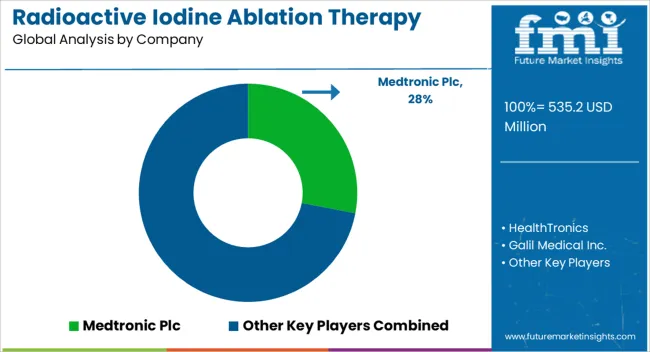
| Item | Value |
|---|---|
| Quantitative Units | USD 535.2 Million |
| Application | Papillary Thyroid Cancer, Follicular Thyroid Cancer, and Hurthle Cell Carcinoma |
| Technology | Gamma Radiation and Beta Radiation |
| End User | Hospitals, Cancer Research Organizations, Radiotherapy Centers, and Research & Development Companies |
| Regions Covered | North America, Europe, Asia-Pacific, Latin America, Middle East & Africa |
| Country Covered | United States, Canada, Germany, France, United Kingdom, China, Japan, India, Brazil, South Africa |
| Key Companies Profiled | Medtronic Plc, HealthTronics, Galil Medical Inc., AngioDynamics, Misonix Inc, SonaCare Medical, Boston Scientific Corporation, and Neuwave Medical Inc |
The global radioactive iodine ablation therapy market is estimated to be valued at USD 535.2 million in 2025.
The market size for the radioactive iodine ablation therapy market is projected to reach USD 871.8 million by 2035.
The radioactive iodine ablation therapy market is expected to grow at a 5.0% CAGR between 2025 and 2035.
The key product types in radioactive iodine ablation therapy market are papillary thyroid cancer, follicular thyroid cancer and hurthle cell carcinoma.
In terms of technology, gamma radiation segment to command 61.2% share in the radioactive iodine ablation therapy market in 2025.






Our Research Products

The "Full Research Suite" delivers actionable market intel, deep dives on markets or technologies, so clients act faster, cut risk, and unlock growth.

The Leaderboard benchmarks and ranks top vendors, classifying them as Established Leaders, Leading Challengers, or Disruptors & Challengers.

Locates where complements amplify value and substitutes erode it, forecasting net impact by horizon

We deliver granular, decision-grade intel: market sizing, 5-year forecasts, pricing, adoption, usage, revenue, and operational KPIs—plus competitor tracking, regulation, and value chains—across 60 countries broadly.

Spot the shifts before they hit your P&L. We track inflection points, adoption curves, pricing moves, and ecosystem plays to show where demand is heading, why it is changing, and what to do next across high-growth markets and disruptive tech

Real-time reads of user behavior. We track shifting priorities, perceptions of today’s and next-gen services, and provider experience, then pace how fast tech moves from trial to adoption, blending buyer, consumer, and channel inputs with social signals (#WhySwitch, #UX).

Partner with our analyst team to build a custom report designed around your business priorities. From analysing market trends to assessing competitors or crafting bespoke datasets, we tailor insights to your needs.
Supplier Intelligence
Discovery & Profiling
Capacity & Footprint
Performance & Risk
Compliance & Governance
Commercial Readiness
Who Supplies Whom
Scorecards & Shortlists
Playbooks & Docs
Category Intelligence
Definition & Scope
Demand & Use Cases
Cost Drivers
Market Structure
Supply Chain Map
Trade & Policy
Operating Norms
Deliverables
Buyer Intelligence
Account Basics
Spend & Scope
Procurement Model
Vendor Requirements
Terms & Policies
Entry Strategy
Pain Points & Triggers
Outputs
Pricing Analysis
Benchmarks
Trends
Should-Cost
Indexation
Landed Cost
Commercial Terms
Deliverables
Brand Analysis
Positioning & Value Prop
Share & Presence
Customer Evidence
Go-to-Market
Digital & Reputation
Compliance & Trust
KPIs & Gaps
Outputs
Full Research Suite comprises of:
Market outlook & trends analysis
Interviews & case studies
Strategic recommendations
Vendor profiles & capabilities analysis
5-year forecasts
8 regions and 60+ country-level data splits
Market segment data splits
12 months of continuous data updates
DELIVERED AS:
PDF EXCEL ONLINE
Ablation Technology Market Size, Share, and Forecast Outlook 2025 to 2035
Global Ablation Devices Market Trends - Growth, Innovations & Forecast 2025 to 2035
IV Therapy and Vein Access Devices Market Insights – Trends & Forecast 2024-2034
Mesotherapy Market Size and Share Forecast Outlook 2025 to 2035
Cryotherapy Market Growth - Demand, Trends & Emerging Applications 2025 to 2035
Aromatherapy Market Size and Share Forecast Outlook 2025 to 2035
Radiotherapy Positioning Devices Market Size and Share Forecast Outlook 2025 to 2035
Cell Therapy Systems Market Size and Share Forecast Outlook 2025 to 2035
Chemotherapy-Induced Nausea And Vomiting Therapeutics Market Size and Share Forecast Outlook 2025 to 2035
Phototherapy Lamps And Units For Aesthetic Medicine Market Size and Share Forecast Outlook 2025 to 2035
Phototherapy Equipment Market Size and Share Forecast Outlook 2025 to 2035
Phototherapy Treatment Market Size and Share Forecast Outlook 2025 to 2035
Heat Therapy Units Market Analysis - Size, Share, and Forecast 2025 to 2035
Chemotherapy Induced Anemia Market Trends and Forecast 2025 to 2035
Radiotherapy Patient Positioning Accessories Market Trends – Forecast 2025 to 2035
Phototherapy Lamps Market Growth - Trends & Forecast 2025 to 2035
Gene Therapy in CNS Disorder Market Analysis by Indication, Type, End User, and Region through 2035
Radiotherapy Device Market is segmented by External Beam Radiation Therapy Device and Internal Beam Radiation Therapy Device from 2025 to 2035
Chemotherapy-Induced Oral Mucositis Market – Growth & Forecast 2025 to 2035
Chemotherapy-Induced Myelosuppression Treatment Market Growth - Forecast 2025 to 2035

Thank you!
You will receive an email from our Business Development Manager. Please be sure to check your SPAM/JUNK folder too.
Chat With
MaRIA